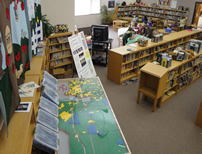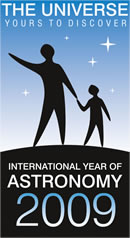3D Model on Display at Mary Frank
Students built a model of the results of the Let There Be Night experiment using over 35,000 LEGO blocks to represent the ideal night sky. From that 3D map, over 12,000 blocks had to be removed to represent the night sky lost to light pollution, according to over 3,400 student observations. The 3D model is displayed at Mary Frank, right, November 2-6, 2009.
Bring on the Night!
LTBN launched March 14, 2009, under clear skies at Mary Frank Elementary School. Friends of SLT members as well as some Northpoint students joined us to look through a telescope before the 9:30 p.m. observation. Venus was showing a crescent phase; Saturn clearly had a thin ring that is near edge-on, and it's moon Titan (see illustration) was readily visible nearby; and the Orion Nebula was a fuzzy patch where new stars are forming. Fortunately the back parking lot lights were off, though the glare of some Granger businesses in particular was apparent.
Then the SLT members went into the field to their designated spot to record the SQM readings. Thanks to all the parents and visitors who came early and stayed late. The Iridium flare that Mr. Bueter promised was actually supposed to appear the next night, Sunday. (Sorry about the gaffe.)
Keep looking to the What's Up? page for other highlights in the sky, like the International Space Station (ISS). Hopefully, most kids took advantage of stunningly clear skies on a weekend night and recorded their magnitude chart #s.
Mary Frank Teachers Have Key Role
On September 22, 2008, Northpoint teachers prepare for LTBN at the first of two in-service sessions. The support of teachers is paramount to the success of this community-wide science experiment.
One teacher, Darlene Seufert, taught longitude and latitude by taking ideas from three different internet sources. Students first played Valentine Battleship (it was right before Valentine's Day) to introduce the idea of grids. They then did a lesson from National Geographic to introduce latitude and longitude. The teacher finished up by showing the children how to use http://www.itouchmap.com/latlong.html to find the latitude and longitude for their address. She sent home a form for them to fill out with their address, latitude and longitude. It took about an hour to do all three activities.
